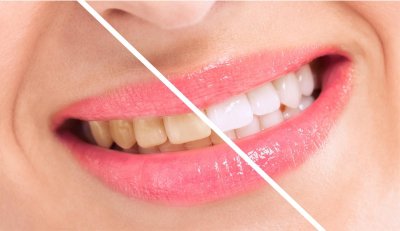It’s a fact of life: Teeth change color. If you’re like countless people all over the world, you may have noticed your pearly whites taking on a yellow tint over the years or, perhaps, you’ve looked in the mirror and seen the tell-tale brown dots or white streaks—but why does it happen and is there anything orthodontic care can do about it?
Extrinsic Stains
The most common cause of discoloration is staining of the enamel, and the most common cause of staining is food and drink. The good news is that you can avoid these extrinsic, or surface, stains by watching what you put in your mouth. The bad news is that it’s hard to give up your favorite snacks and refreshments.
The most notorious culprits are:
- Tea: Tea is one of the worst offenders, possibly even worse than coffee. In addition to containing a lot of pigment-producing substances called chromogens, it’s also full of tannins, which help those chromogens attach to your tooth enamel.
- Coffee: You probably know coffee stains teeth, but did you know that adding cream and milk won’t do a thing to stop it? While it may turn your coffee white, it certainly won’t do the same for your teeth.
- Wine: Add a wealth of tannins to the naturally dark pigment of red wine, and it’s no wonder your teeth come away looking worse for the wear.
- Cola: Like all the other items on this list, cola is high in chromogens, which add a nice dark pigment to both the drink and your teeth.
- Fruits: Yes, even grapes and blueberries and pomegranates can stain your teeth. Acidic fruits also have a tendency to wear away tooth enamel, which doesn’t help the staining problem.
- Tobacco : Using tobacco in any form (smoked or chewed) is a sure way to lose the luster of your smile.
If you can’t avoid foods and beverages that stain your teeth, you’ll have to go the extra mile and practice superior oral hygiene. That means brushing often (at least twice a day or, better yet, after eating and drinking), using mouthwash, and flossing once a day.
Whether or not you indulge in three cups of tea or grape juice per day, it’s a good idea to take care of your mouth. That’s because poor oral hygiene creates plaque and bacteria buildup, which is also a leading cause of tooth discoloration.
Intrinsic Stains
Some discoloration goes beneath the surface, affecting the enamel itself or even the underlying dentin.
- Medications: Certain antibiotics (namely tetracycline and doxycycline) can stain children’s teeth if they’re still developing. A number of commonly used medications, including some prescription-strength mouthwashes that contain chlorhexidine, can cause discoloration in adults who use them. Even overexposure to fluoride can permanently affect the color of teeth.
- Radiation and Chemotherapy: Chemotherapy drugs and radiation directed at the head can affect the teeth.
- Disease: High fevers in childhood can cause discoloration, as can jaundice or overall poor health.
- Age: As we age, the enamel on our teeth wears out and becomes thinner. That allows the natural yellow of your dentin to show through more clearly.
- Genetics: Unfortunately, some people are simply born with thinner enamel and, therefore, have more yellow-looking teeth.
Does Orthodontic Care Cause Tooth Discoloration?
There’s a widely-held but misguided belief that traditional braces cause tooth discoloration. The materials used 
At Labbe Family Orthodontics, we work with each individual to improve their overall oral care while they’re undergoing treatment. That means educating patients about good hygiene practices and nipping problems in the bud before they have time to cause permanent problems like tooth discoloration. As a top orthodontist in Maryland, we’ll do everything we can to ensure that your smile is picture perfect. Take advantage of our online resources to learn more tips and tricks for taking care of your teeth.





